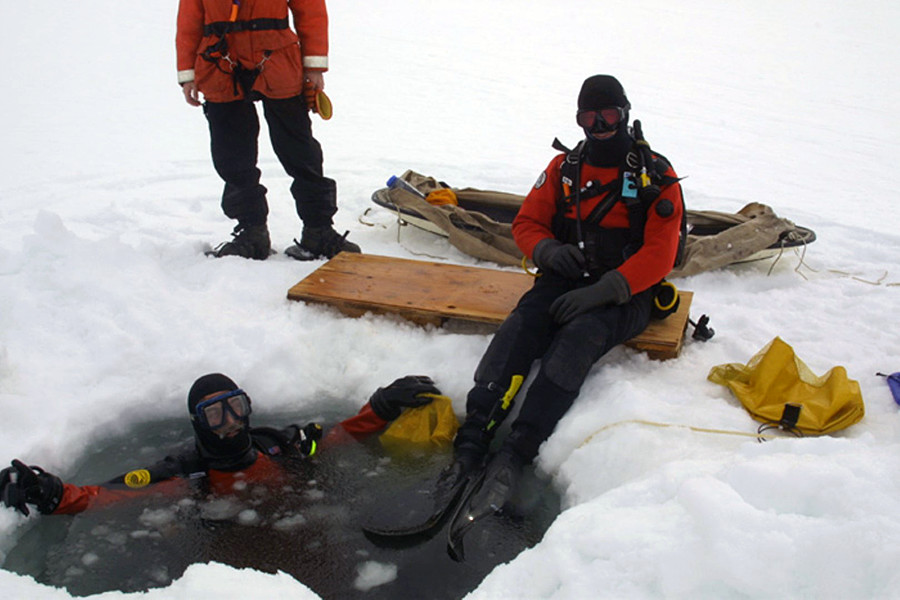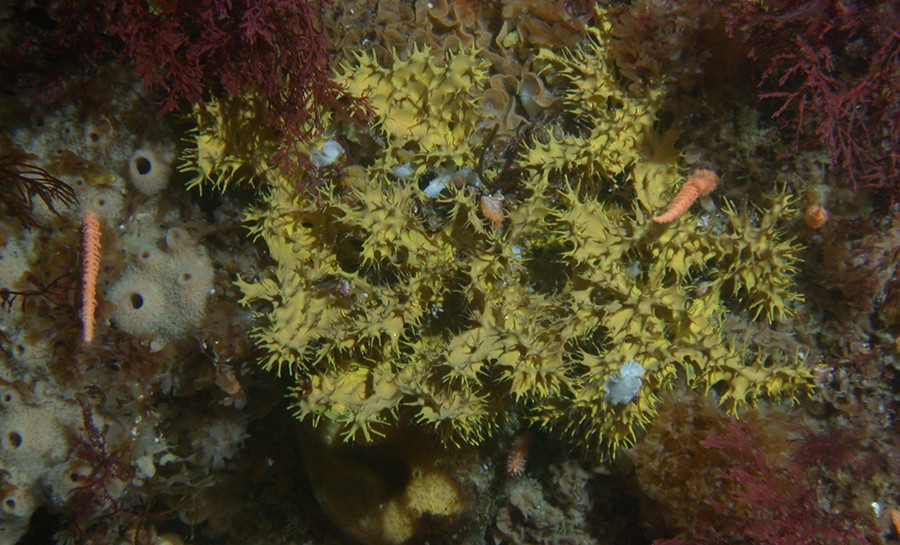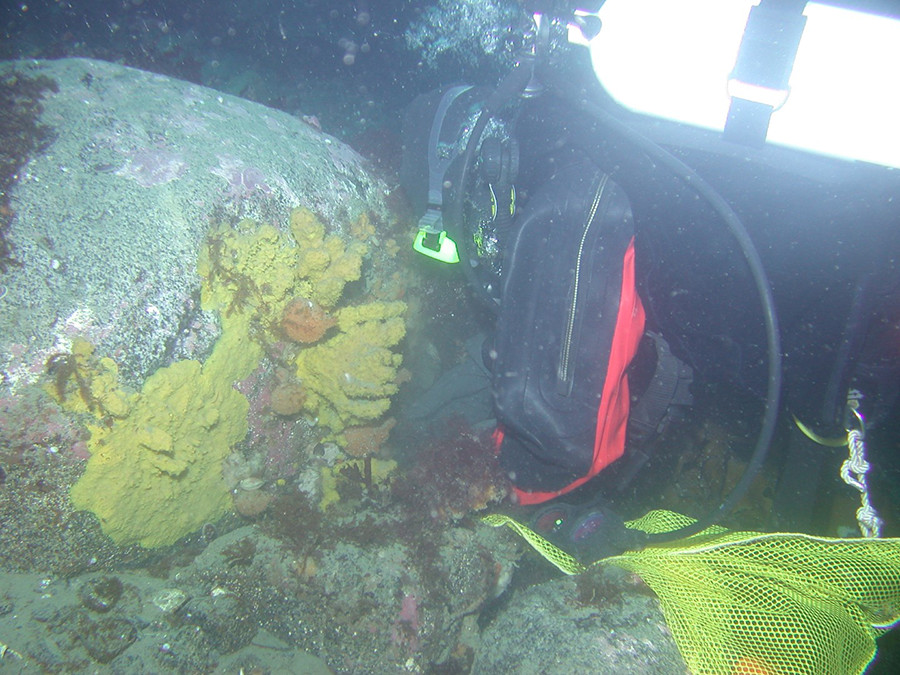Antibiotics from a SpongeCould a new compound from Antarctic sea sponges be the key to breaching MRSA’s impregnable barricades?Posted June 21, 2016

Photo Credit: Jim McClintock
Bill Baker and his team dive off of Palmer Station to collect samples of the marine life that live in Antarctic waters.
A newly discovered chemical compound found in an Antarctic sea sponge shows promise as a potential way to develop treatments against the fortified form of some of the most virulent antibiotic-resistant infections. Researchers analyzing the sea sponge Dendrilla membranosa discovered the new compound they dubbed “darwinolide.” They found that it has antibiotic properties, but importantly that it was most effective against colonies of antibiotic-resistant infections behind their nearly impenetrable natural barricade. “It fights off one of the hardest barriers in MRSA to fight, which is the biofilm,” said Jaqueline Fries, a postdoctoral research fellow at Simon Frasier University and lead author of the team’s recent paper. “It’s pretty selective towards that, which is important for any kind of antibiotic research.” The team’s results were published Researchers have been scouring the globe to find samples of new chemical compounds that could potentially be synthesized into new treatments. The Antarctic stands out as one of the last major untapped resources for this kind of exploration. “A lot of people don’t get to the Antarctic, so there are a lot of things that have not been explored there,” said Renee Fleeman, who was the lead microbiology student at the University of South Florida (USF) on the project. “There’s a lot of diversity that has been undiscovered, and there’s a lot of things that we can find from the natural products in Antarctica.” Researchers think also that not only has the frigid climate prevented extensive exploration of the area, it also spurs animals like sponges to evolve their own natural defenses. “It’s a unique environment and it’s also an exotic environment,” Fries said. “The chances of it having unique chemistry to adapt to this environment that not a lot of people have looked at are higher.” Methicillin-resistant Staphylococcus aureus, more commonly known by its acronym MRSA, is a deadly kind of staph infection that is resistant to most known antibiotics. Finding new ways to combat it has been a top priority for drug researchers around the world. This new compound, darwinolide, shows promise because lab tests showed that it’s surprisingly effective against some of the most difficult to treat forms of MRSA. “If we can use it as a lead for new compounds that could fight any of these bacterial resistances that have been showing up, that would be great,” Fries said. There are two different forms that a MRSA infection can take. Free-swimming, independent bacteria that move freely throughout the body is one form, but on surfaces like medical implants, the bacteria can grow into colonies with a protective mucus-like cover. “They all grow together and start excreting gooey DNA and polysaccharides and it’s just like an impermeable membrane where things can’t get in but they can still get their nutrients to survive,” said Fleeman. On its own, free-swimming MRSA is difficult to kill, but this biofilm membrane seriously compounds the problem. The barriers put up by the bacteria are almost impervious to treatment, making them essentially impossible to eradicate once they’ve established themselves. These infections especially thrive on artificial surfaces like stents or prosthetic implants. “Once it forms on something that’s been implanted, you just have chronic infections over and over until they can remove the implant and place a clean one in,” Fleeman said. The team tested darwinolide against both forms of MRSA and found that it was more effective against these kinds of toughened biofilms than it was against free-swimming cells. “It's activity against free growing cells is not particularly impressive, but it’s much better against biofilms,” said Lindsey Shaw, a professor of microbiology at USF. “That’s backwards; you usually have good activity against free growing cells and no activity against biofilms.” This came as a big surprise to the team. “It’s very unusual.” Fleeman said. “I have not worked with anything yet that has this kind of activity towards biofilms.”
“There’s a lot of diversity that has been undiscovered, and there’s a lot of things that we can find from the
natural products in Antarctica.”
Shaw echoed her sentiment. “I’ve never seen it,” he said. “We rarely see anything that hits a biofilm, and we’ve never seen anything that prefers biofilms over regular cells.” Though these initial results seem promising, darwinolide in its current form is far from viable antibiotic for people. The researchers hope to synthesize more of it and further investigate its unique properties. “We’re not really going to push darwinolide as a drug,” said Bill Baker, a professor of chemistry at USF. “What we’re going to do is try to make modifications of the molecule that will increase its potency, increase its drug-like properties and hopefully make it into something that really has potential as a drug.” In fact, any treatment that may ultimately result from this research will likely feature a chemical compound that only bears a slight resemblance to what the sponge originally secreted. The focus for researchers working on this compound over the next few years is to make different variations of the chemical to understand how it is that darwinolide is so effective against biofilms. “Ultimately, what we would like to do is figure out through these series of derivatives what part of the molecule makes it hit biofilms selectively,” Baker said. “If we can tell what arrangement of atoms makes it so selective, we might be able to design a new antibiotic that looks nothing like darwinolide, but it has that arrangement of atoms that makes it selective to those biofilms.” The sponge that yielded darwinolide was originally collected in the oceans around Palmer station, along the Antarctic Peninsula. James McClintock and Chuck Amsler, both at the University of Alabama at Birmingham, have been leading the effort to sample and study 
Photo Credit: Joanna Hubbard
Bill Baker (left) and Chuck Amsler emerge from the water after a dive through a hole drilled in the ice.
“Natural products in general are really the largest source of antibiotics today,” Fleeman said. “That is where we mainly get our antibiotics from.” Sponges in particular have long been the focus of antibiotic research because they produce a range of compounds to manage the bacteria that build up on them. “They have really rich microbial communities,” Fries said. “Sponges are one of the richest sources of microbes in the ocean.” This species of sponge had previously yielded samples of other compounds with some antibiotic properties, so when the researchers found the new compound, they were keen to try it on a variety of bacteria. It’s likely that the sponge originally evolved to secrete darwinolide to help moderate some of this microbial buildup. Finding the new compound in Dendrilla membranosa also came as a surprise to the researchers. This species of sponge has been studied for years and it had never been seen before. “We weren’t looking for it, it sort of came out of our process,” Baker said. “This compound had never been reported in the chemical literature before. It’s a brand new compound. The structural features of it are quite unusual as well. In fact I’d say it’s only every few years we come across a compound that’s this different than anything that’s been reported before.” Baker added that he thinks that likely only a small portion of sponges have evolved to secrete this compound so far, and his team was lucky to have picked one that had. But they’ll keep looking. “We’ve been doing this type of work in Antarctica for a couple of decades now,” Baker said. “In future field seasons in Antarctica, we will target the collection of Dendrilla to look further for this compound.” NSF-funded research in this article: Bill Baker, University of South Florida, Award No. 0838776 |



For USAP Participants |
For The Public |
For Researchers and EducatorsContact UsU.S. National Science FoundationOffice of Polar Programs Geosciences Directorate 2415 Eisenhower Avenue, Suite W7100 Alexandria, VA 22314 Sign up for the NSF Office of Polar Programs newsletter and events. Feedback Form |



